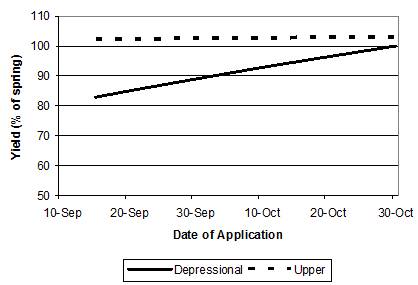A Fall Fertilization Refresher
Prepared by John Heard, MB Ag Soil Fertility Specialist
The past few wet years have played havoc with the traditional practices of fall nitrogen (N) fertilization. In many cases the N losses have been high, resulting in low yields and/or protein, and in extreme cases some fertilized fields went unseeded.
So in recent weeks I have had calls from growers either switching to spring, one-pass seeding and fertilizing or wanting some assurance that their fall fertilization program was in order. So a refresher on the practice is warranted.
The major premise of efficient fall fertilization is to keep N overwintering in the ammonium form. This NH4+ form is a cation and is held by the cation exchange surfaces on negatively charged clay and organic matter particles. No amount of rain will dislodge and leach N when it remains in this form. Likewise denitrification is a bacterial conversion of nitrate (NO3-) nitrogen to a gaseous form that is lost. But again the N must be converted to the ammonium form before this is a concern.
Several practices may help keep fall applied N in the ammonium form:
- A slow release coating on urea will delay urea from escaping into the soil, let alone converting to nitrate (like ESN)
- Use of nitrification inhibitors:
- Nitrapyrin in N-Serve for anhydrous ammonia or eNtrench for usea is toxic to the nitrifying bacteria
- The DCD in SuperU has bacteriostatic activity that inhibits nitrifying bacteria
A nitrification inhibitor, like DCD in SuperU, is toxic to the nitrifying bacteria - The initial “ammonia shock” of a urea or ammonia band temporarily kills bacteria and fungi within the injection zone. The temporary bacterial absence delays the conversion of ammonia to nitrate. The more concentrated the injection zone, the slower the recolonization by bacteria.
- Application to cool soils means the bacteria perform slower (see Table 1).
Table 1. Nitrification rates of ammonia to nitrate form-N from banded urea (calculated from Tiessen et al, 2003).
Average soil |
Days for 50% |
Days for 100% |
| 1 oC | 190 |
380 |
| 5 oC | 40 | 80 |
| 10 oC | 20 | 40 |
| 15 oC | 13 | 25 |
| 20 oC | 10 | 20 |
One can check the range of temperatures observed in our soils by accessing the Manitoba weather network data: http://www.gov.mb.ca/agriculture/weather/soil-temperature.html This shows the 2-week soil temperature trend for 36 stations across Manitoba. Temperatures are taken at the 2 inch depth under sod.
Past guidelines suggested farmers should delay applications until soils cool to 5oC. However this ignores the vagrancies of fall weather which may thwart sufficient application before fall freeze-up. Growers need to gauge their starting date by their soil conditions and the number of days required for application. Another consideration for Manitoba farmers is that all fertilizer applications should be completed by November 10 in order to comply with current Water Protection Act regulations. This is the date selected as the “start of winter” and extends until April 10.
For best performance it is even better that these bands not be disturbed with spring tillage or seeding operations.
But N losses with early application do not always occur. Figure 1 shows that Manitoba research locations that were well drained, upper slopes performed as well or better* than spring banded N (*sometimes banding into wet, cold soils prior to seeding can muck up the seedbed reducing stands). However, under wet environments and poorly drained, depressional soil, the N losses and yield penalty with early banding on warm soils are unacceptably high.
Figure 1. Effect of date of fall N application on spring wheat grain yields from fall-banded urea relative to spring-banded urea at depressional and upper slope positions at three sites near Winnipeg and one site near Brandon (2001-2002).1

Growers are also asking for pointers on fall phosphorus (P) applications. Some of our high P removing crops like soybeans and canola cannot safely tolerate their removal amounts when seedplaced. Fall phosphorus application is an option. The availability of this phosphorus is improved if it is dual banded with nitrogen or ammonium sulphate. Spacing of bands should be 12” or less so bands are not too far away from future rows. And ideally these bands should remain intact and not disrupted by spring seeding or tillage. Application of some P fertilizer with the seed may still be advantageous if soils are cold in the spring or soils are very low in P.
In summary, there is little new about fall fertilization principles. Band ammonium-based fertilizers to cool soils. Consider nitrification inhibitors or controlled release products if applying N to warm soils especially if those soils are likely to suffer waterlogged conditions.
References
6 Tiessen, K., D. Flaten, C.A. Grant, R.E. Karamanos, D.L. Burton and M.H. Entz. 2003. Efficiency of fall-banded N: Effects of application date, landscape position and inhibitors. Manitoba Agronomist Conf. Proc. http://www.umanitoba.ca/faculties/afs/MAC_proceedings/2003/pdf/flaten_fall_banded_N.pdf
